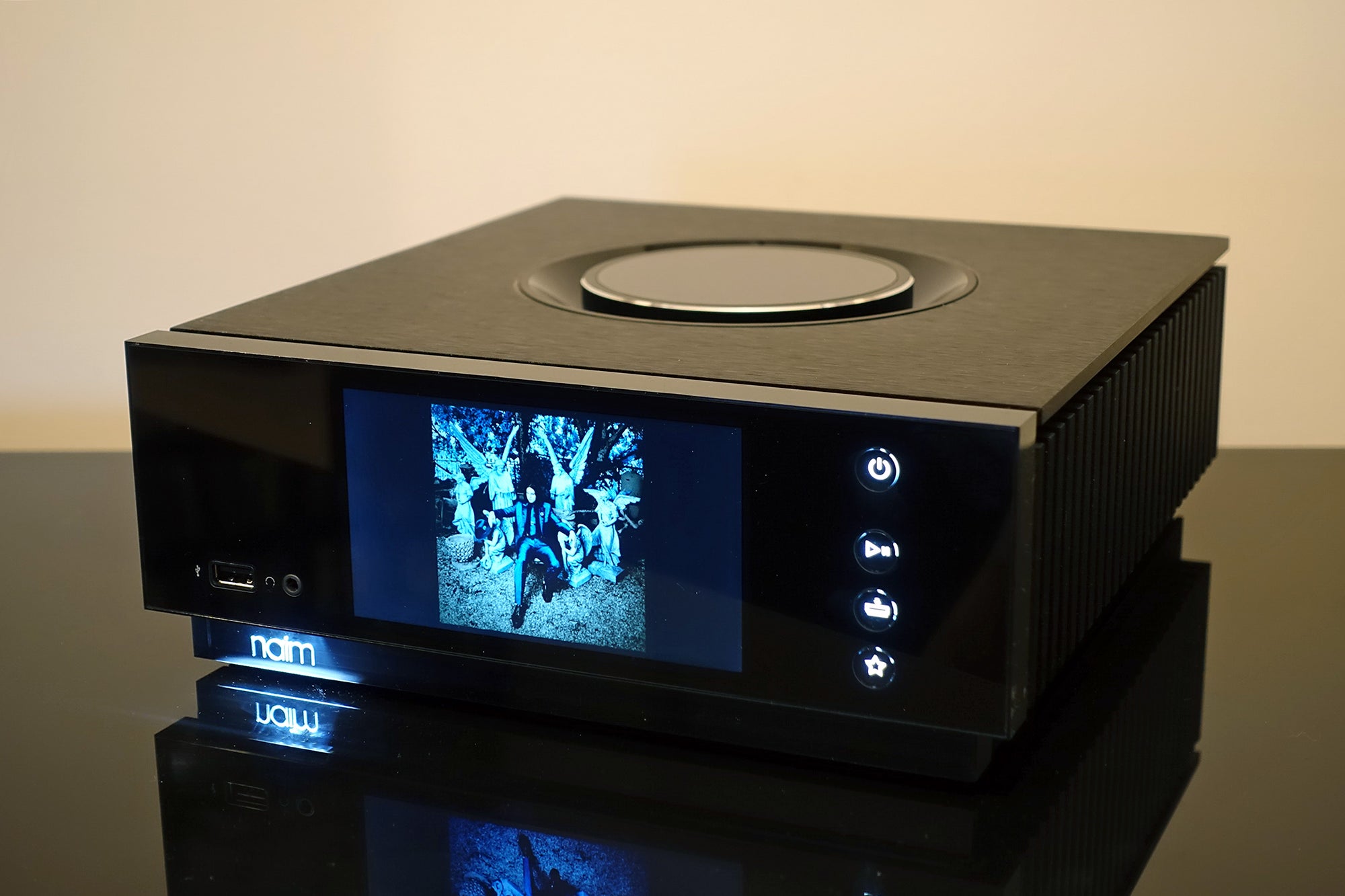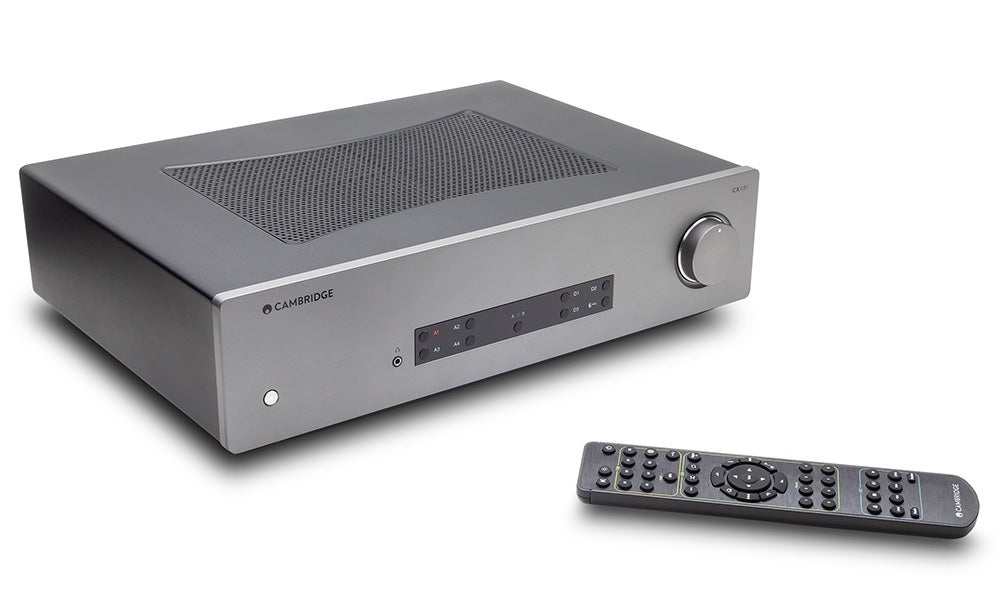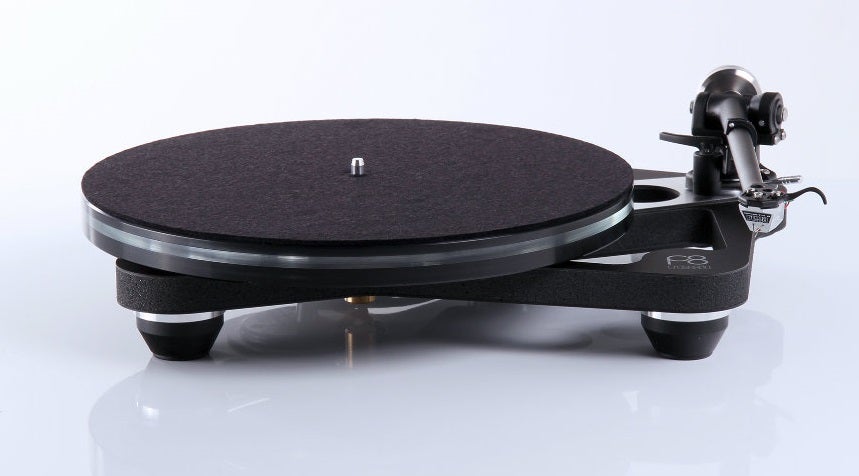Bluesound Powernode Review
An audiophile streaming amplifier
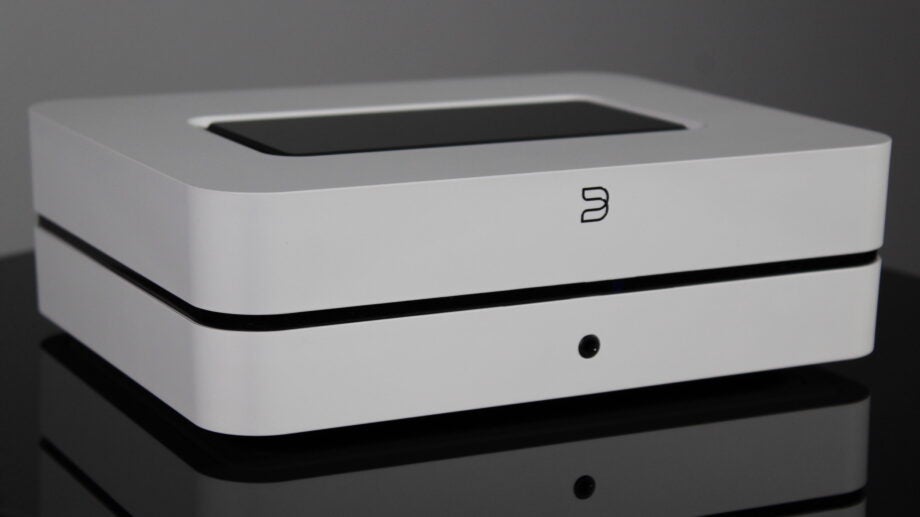

Verdict
Just add speakers to this impressive streaming amplifier and you’ve got a capable and affordable wireless system built around an audiophile DAC, quad-core processor and a powerful stereo soundstage. The excellent BluOS control app, extensive connectivity and easy setup are the cherries on top.
Pros
- Impressive overall performance
- Powerful amplification
- Excellent set of features
- Easy to setup and use
- Extremely well made
Cons
- No remote control included
- No DSD support
Availability
- UKRRP: £849
Key Features
- Built-in amplificationHybridDigital stereo power amplifier capable of delivering 80 watts per a channel
- Audiophile-grade processingTexas Instruments PCM 5242 DAC and ARM Cortex A53 quad-core processor
- BluOS operating systemMulti-room/multichannel functionality and Controller app
- Physical connectivityHDMI eARC; digital and analogue inputs; USB; Ethernet
- Wireless connectivityDual-band Wi-Fi 5; Bluetooth 5.0 aptX HD; AirPlay 2
Introduction
The Bluesound Powernode is the natural extension of the company’s Node network streamer, taking everything that makes that model great and adding built-in amplification.
The result is an easy and affordable way to create a capable Hi-Fi – just add speakers and you’re good to go. In addition to the HybridDigital two-channel amp, the Powernode includes an audiophile DAC, quad-core processor, and touch panel controls. It also supports high-res music streaming services up to 24-bit/192kHz, plus there’s extensive connectivity, and the BluOS Controller app.
Design
- Compact and stylish
- Touch-sensitive controls
- Excellent build quality
- Choice of black or white
The Bluesound Powernode looks almost identical to the Node, with the same basic curved chassis and touch-sensitive LED panel on top. Wave your hand over the panel and a proximity sensor lights up a volume slider, along with previous/next track, and play/pause controls. It also adds five presets to which you can allocate functionality using the BluOS Controller app.
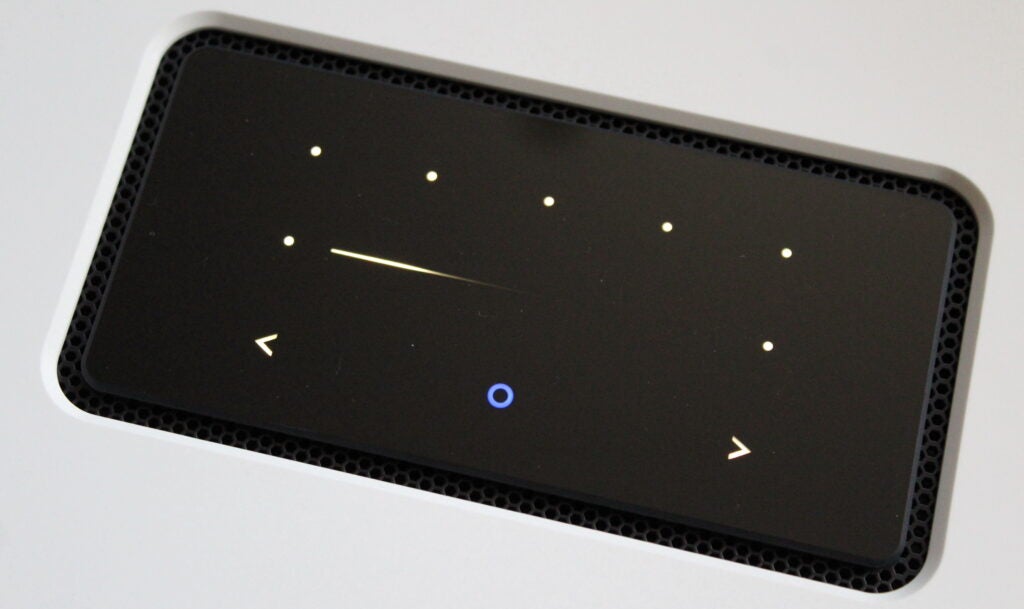
The design of the chassis is sleek and clean, with two matte sections sandwiched either side of a glossy strip – where you’ll find a small indicator LED, and an IR sensor. Beneath that you’ll find a 3.5mm headphone jack, but all the other connections are at the rear.
The main visual difference compared to the Node is that the Powernode is bigger and heavier because of the built-in amp. It measures 220 x 70 x 190mm (WHD), weighs in at 1.78kg, but still comes in a choice of black or white.
Connectivity
- HDMI eARC, digital, analogue, USB and Ethernet connections
- Support for Wi-Fi 5, Bluetooth 5.0 aptX HD, AirPlay 2
- Wired and wireless headphone outputs
- Wired and wireless subwoofer outputs
The Bluesound Powernode offers similar connectivity to the Node, which is good because the latter really impressed in this regard. The main differences are the addition of a pair of five-way binding posts for the built-in stereo amplifier, and the removal of unnecessary digital and analogue outputs and 12V trigger because the Powernode has its own on-board juice.
There’s an HDMI eARC connector, which is sensible because it immediately allows you to boost the audio performance of your TV, while also offering multichannel expansion options later. There are dual-function optical digital/analogue inputs, and a dedicated subwoofer output, along with an IR-in, a USB Type-A connector, and a Gigabit Ethernet port for a wired connection.
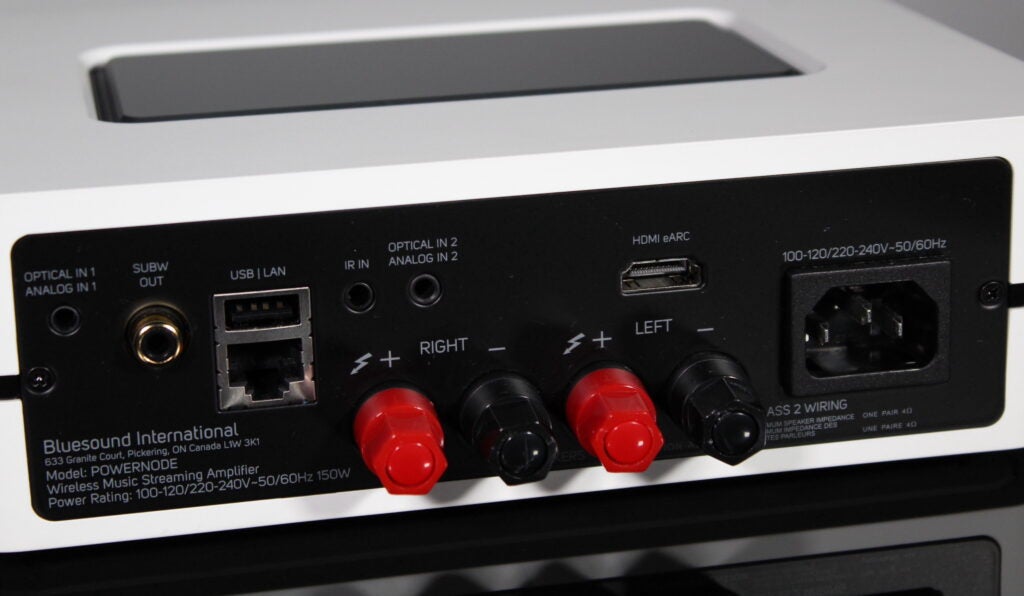
In terms of wireless connectivity, there’s dual-band Wi-Fi 5 and Bluetooth 5.0 aptX HD with two-way connectivity (transmit and receive), allowing you to stream 24-bit audio directly from a phone or tablet, and transmit it back to any paired headphones or speakers. Finally, there’s AirPlay 2 for those with Apple devices, and even a wireless output for the optional Pulse Sub+ subwoofer.
Features
- HybridDigital amp (2 x 80W)
- 32-bit/384kHz DAC
- BluOS Controller app
- Hi-Res Audio support
- Multi-room functionality
- Works with Alexa, Google and Siri
As mentioned, the Bluesound Powernode shares a number of features with the Node, but the obvious difference is that the Powernode includes a HybridDigital stereo power amplifier that can deliver 80W per channel into an 8-ohm load. So just add a pair of decent speakers and you’ve got a very capable streaming system that can deliver plenty of grunt with minimal distortion.
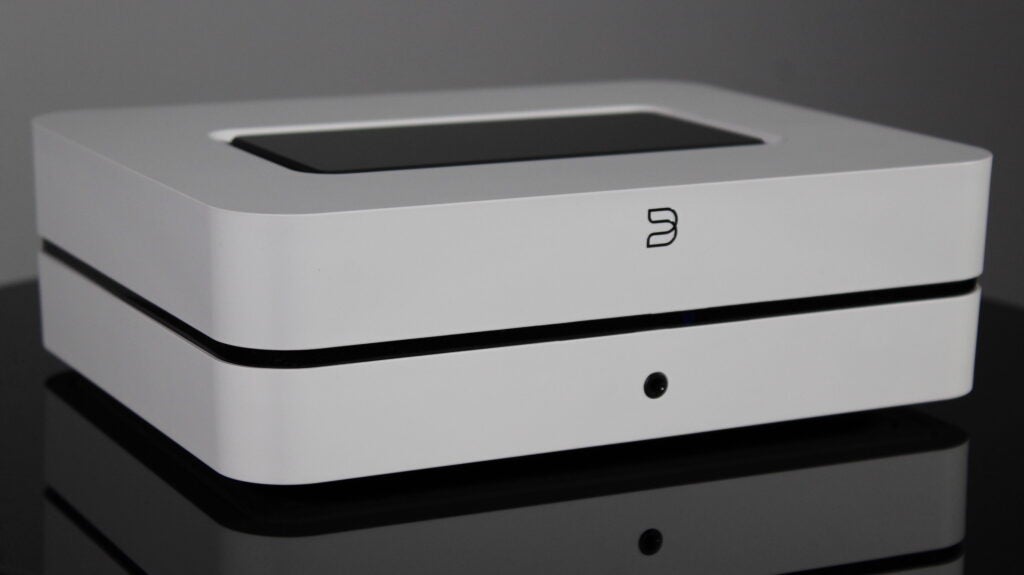
There’s an audiophile DAC with a 32-bit/384kHz design that’s paired with a quad-core processor, although like the Node, this is limited to processing high-resolution audio up to 24-bit/192kHz. This streaming amplifier includes the BluOS operating system, which in turn supports controller operating systems from iOS, Android, Windows and Mac.
The Powernode can handle just about any audio format imaginable, including MQA. While it can’t deal with DSD, BluOS is capable of identifying DSD files and cross-converting them to FLAC. It also offers every streaming service you can think of, including Tidal, Spotify, and Qobuz, plus there’s internet radio and access to any digital music library you have on a computer or external drive.
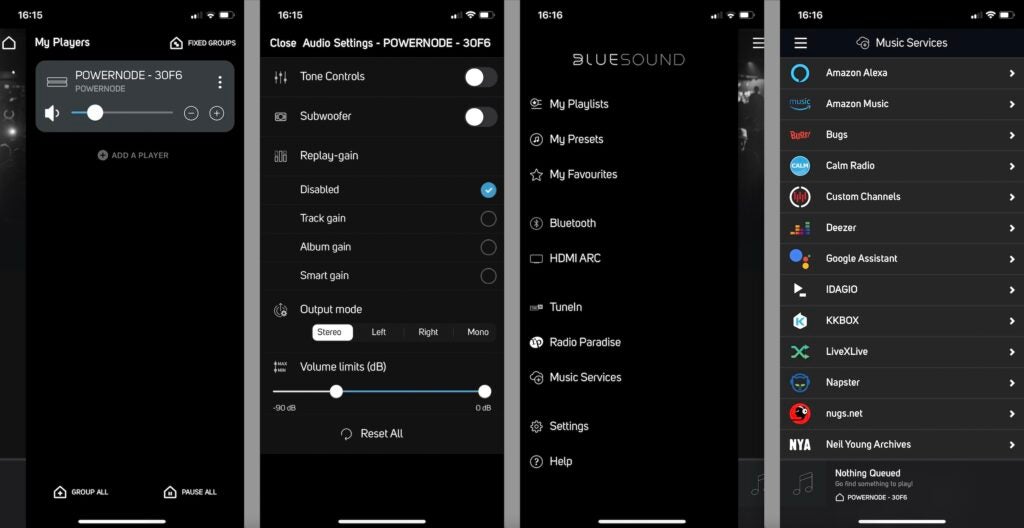
Bluesound has created its own multi-room system based around the excellent BluOS Controller app. This seamlessly connects the Powernode to other Bluesound speakers around your home, creating an intuitive multi-room music system. It can also run a wireless Dolby surround system using a pair of wireless Pulse Flex 2i speakers at the rear and a wired or wireless subwoofer.
There’s no included remote, but you can control the Powernode using the BluOS app, touch panel controls, or voice assistants such as Siri, Alexa, or Google Voice. It can also be integrated into a smart home with full-feature drivers for Lutron, Elan, RTI, Crestron, and other popular home control systems.
Sound Quality
- Dynamic and tonally balanced sonics
- Soundstage has plenty of scale
- Amplification is powerful and responsive
- Handles all types of recordings (even poor ones)
The Bluesound Powernode is a fantastic all-in-one unit – simply pair it with a decent set of speakers and you’ll have an accomplished system. Setup couldn’t be easier, and there’s a comprehensive choice of music streamers with support for high-resolution audio and MQA. The BluOS app is also a well-designed controller, making the Powernode a joy to use.
The combination of the audiophile DAC chip and powerful stereo amplifier results in a performance that sounds great with all types of recording – even poor ones. As a result, this amp and streamer is pleasingly forgiving across a varied selection of material, allowing you to partner it with a wide variety of speakers.
The HybridDigital amp produces a forceful stereo delivery that can drive the most demanding of speakers. There’s plenty of headroom in the two 80W channels, which gives recordings a dynamic quality. Cranking up the volume dial doesn’t result in strained or distorted audio, which means it never sounds unnecessarily loud.
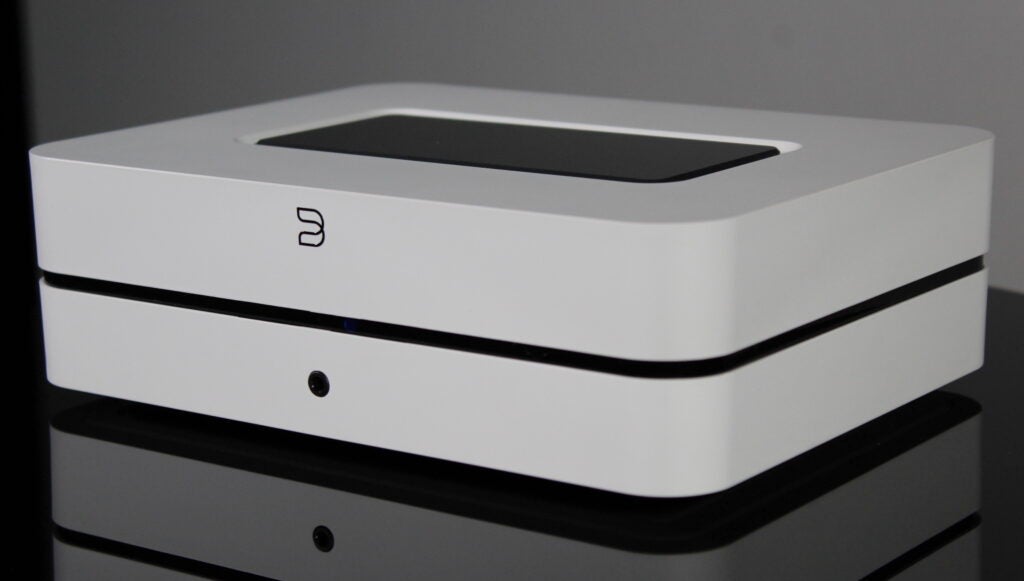
The amplification is responsive, too, turning on a dime and going from kitten’s breath to ear-slitting in an instant. This agility is combined with a performance that’s wonderfully energetic, making the overall delivery exciting and fun. There’s also excellent bass detail and frequency extension that combines with an insightful mid-range and an engaging soundstage.
The result is a cohesion across the frequency range, with a balanced delivery and excellent levels of detail. Listening to Bernard Butler’s updated version of his debut album People Move On reveals the newly recorded vocals, while also pulling out all of the complex guitar arrangements. Whether its the gloriously anthemic Not Alone, the slow-burn Stay or the acoustically fragile I’m Tired, the Powernode handles them all with amazing skill.
Latest deals
Should you buy it?
You want an easy and affordable way of creating a high-resolution music streaming system that sounds fantastic and offers plenty of features and expansion options. Just add speakers and you’re good to go.
You desperately want DSD support or hate being forced to use a smart device as a remote control.
Final Thoughts
If you’re looking for an easy-to-set-up streaming amplifier, then look no further than the Bluesound Powernode. Pair this capable amp with a decent set of speakers and you’ll be rewarded with a superior Hi-Fi system. Comprehensive connectivity, extensive features and a very effective remote app are all welcome, as is the ability to connect your TV via HDMI-eARC. In fact, there isn’t much this stylish little box can’t do – and it won’t break the bank, either.
How we test
We test every music streamer we review thoroughly over an extended period of time. We use industry standard tests to compare features properly. We’ll always tell you what we find. We never, ever, accept money to review a product.
Tested with real world use
FAQs
The BluOS interface supports Alexa, Google and Siri via an external product (for example an Amazon Alexa compatible speaker).
Full specs
Jargon buster
aptX
Qualcomm’s aptX codec can support higher quality audio than Bluetooth alone.AirPlay 2
AirPlay 2 is the second generation of Apple’s proprietary wireless streaming tech, which is built into all of its hardware products (and supported by many others). It’s designed to pass content from your Apple device - music, video and photos - to a compatible receiver over your Wi-Fi network such as a TV, wireless speaker, AV receiver etc.Hi-Res Audio
Hi-Res audio is referred to as a standard as well as a marketing term that describes digital audio files of better-than-CD quality (16-bit/44.1kHz).

